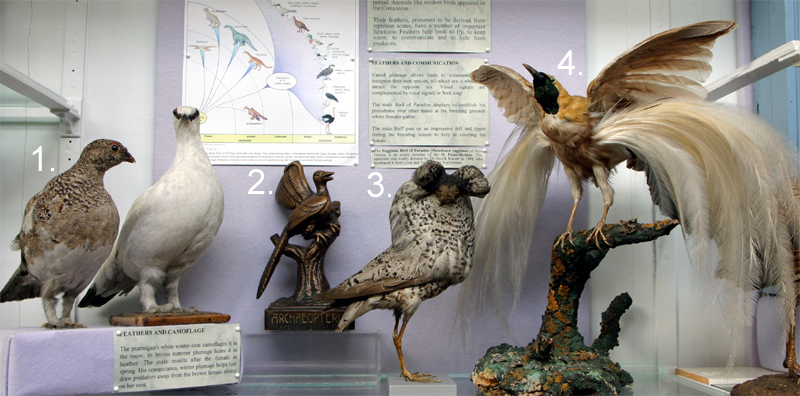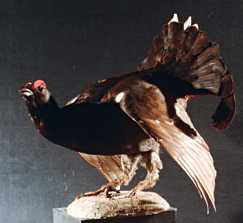
BIRD ORIGINS AND FEATHERS
Birds are descended from creatures like Archaeopteryx, which had feathers, clawed wings and a long-tail and lived in the Jurassic period. Animals like modern birds appeared in the Cretaceous. Their feathers, presumed to be derived from reptilean scales, have a number of important functions.
Feathers serve as insulation, allowing birds to maintain a constant 'warm' internal body temperature, i.e. to be homoiothermic. Homoiothermy permits birds to keep warm when flying at high altitudes or swimming in water and to survive in cold, even sub-zero, environments.
Varied plumage allows birds to communicate: to recognise their own species, tell which sex is which and attract the opposite sex. Visual signals are complemented by vocal signals or 'bird song'.
Different coloured feathers allow birds to camouflage themselves and merge with their back grounds.

1. The ptarmigan, Lagopus mutus, (O. Galliformes) has white feathers in winter that camouflage it in the snow; its brown summer plumage hides it in heather. The male moults after the female in spring. His conspicuous, winter plumage helps him draw predators away from the brown female sitting on her nest.
2. A model of Archaeopteryx.
3. The male Ruff, Philomachus pugnax, (O. Charadriiformes) has special breeding plumage but the female, the reeve, never changes and is very dull. The male Ruff puts on an impressive frill and tippet during the breeding season to help in courting the female.
4. The Raggiana Bird of Paradise, Paradisaea raggiana, of New Guinea is an exotic member of the O. Passeriformes. The male Bird of Paradise displays to establish his precedence over other males at the breeding grounds where females gather. This specimen was kindly donated by Dr Henrik Kacser in 1994, who purchased it from Lyon and Turnbull, the Auctioneers, in Edinburgh.

Black Grouse, Lyrurus tetrix, (O. Galliformes) come together in communal courtship displays in the Scottish hills. The males flaunt their spectacular plumage and lyre-shaped tails to attract the sombre-plumaged females.






